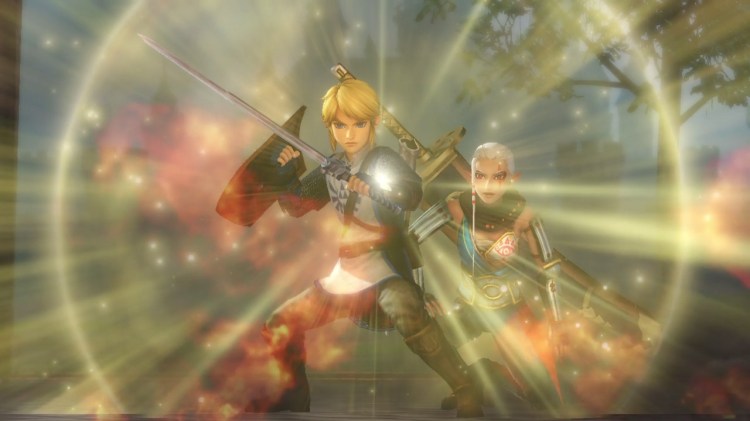No one minds that Nintendo is bringing enhanced Wii U ports to the Switch — the portable console is ideal for revisiting games that underperformed on their original releases. The Switch versions tend to be even better than the originals, too.
If you’re a Legend of Zelda fan who missed Hyrule Warriors when it arrived in 2014, the Definitive Edition is your opportunity to make up for lost time. Under Nintendo’s watchful eye, Koei Tecmo uses Zelda games to reskin its long-lived Dynasty Warriors action-strategy franchise, letting Link and allies hack-and-slash their way through huge armies of monsters. The Switch version includes all the DLC released for the Wii U and 3DS, resulting in a gigantic bundle of fan service.
If you’re considering buying Hyrule Warriors, I would ask you only two questions: Might you get tired of clearing out clusters of similar enemies over and over again? And will you mind that this port hasn’t been optimized for the Switch’s screen in portable mode?
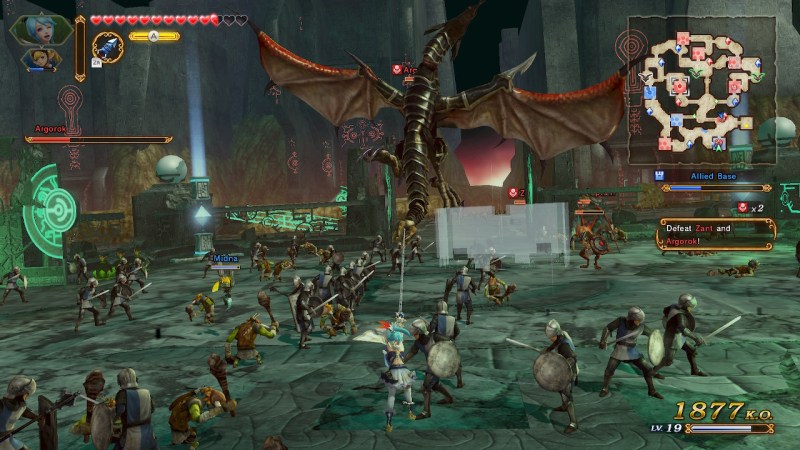
Above: Link and companions face off against hordes of monsters at once, trying to turn enemy-held red crystal areas into friendly controlled blue areas.
What you’ll like
An action-heavy, RPG-light take on The Legend of Zelda
Hyrule Warriors is an action-heavy Zelda game, though it needs to be understood as “strategic action,” rather than an RPG or a raw beat-’em-up. If you’re familiar with the Advance Wars series (or its great-grandfather, Military Madness), Hyrule Warriors is what you get by eliminating the hex grids and turn-based pondering in favor of hacking-and-slashing.
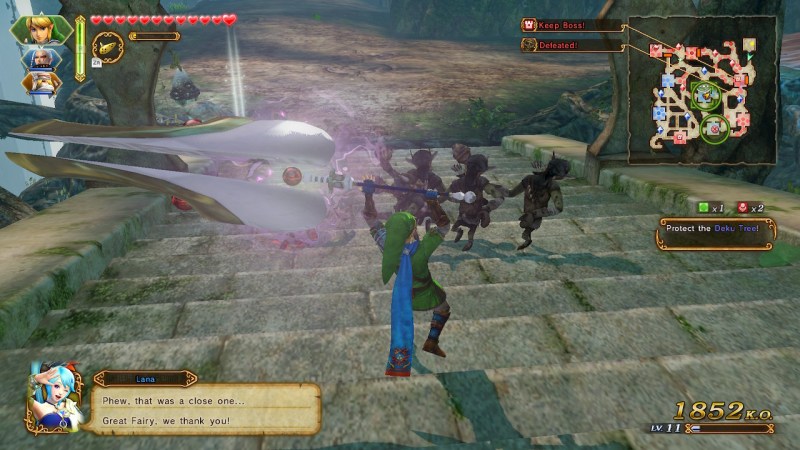
Above: Each of the characters on your team can use multiple weapons, choosing a primary one before the stage.
The standard Hyrule Warriors level is a 30- to 60-minute-long battlefield that you must conquer using a team of several characters. Each of the dozens of levels is filled with thousands of enemies, and you hit 10 or 20 monsters at once with big swings of your weapons. Your goal is to turn areas of the battlefield from evil red to good blue, ending the level with a Zelda dungeon-like boss encounter.
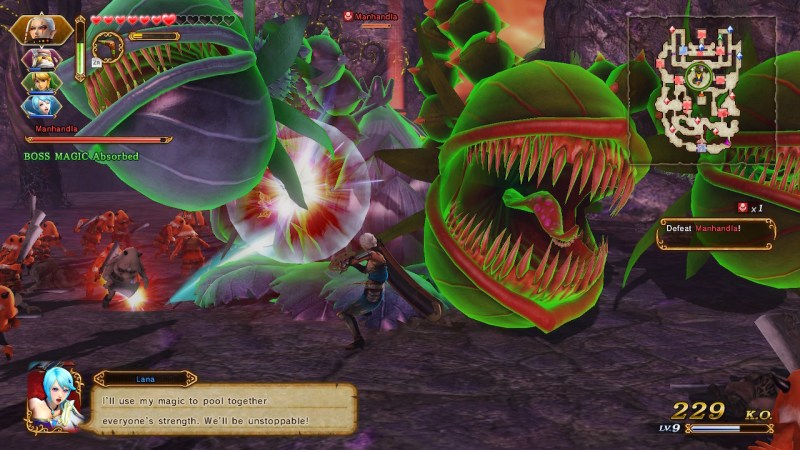
Above: Boss encounters have more than a little classic Zelda dungeon boss inspiration, including the need to use sub-weapons to expose weaknesses.
Nintendo deftly mixes classic Zelda weapons, characters, and themes into each battleground, so Hyrule Warriors feels sort of like a main series game. But once you notice that even basic weapons clear dozens of dumb grunts at once, you begin to realize that your actual objective is to defeat multiple minibosses to seize territory, stopping (and backtracking) only to put out fires indicated with small dialog boxes and tiny red target icons.
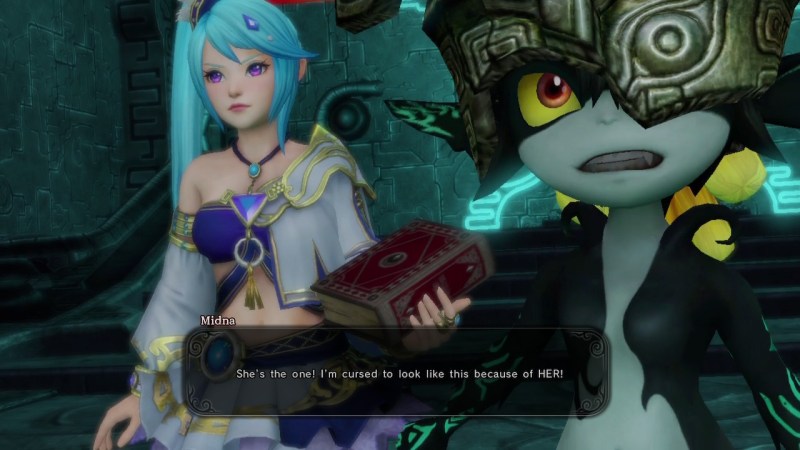
Above: Who appears from the Zelda universe? The better question is: Who doesn’t appear?
Incredible scope of fan service
Between all of the original and DLC content from the Wii U and 3DS versions of Hyrule Warriors, the Definitive Edition overflows with Zelda fan service. You’re constantly unlocking more of the roughly 30 playable characters, including modern, young, and toon Links, the ferocious Impa, different takes on Zelda, freaky Tingle, multiple tribal leaders, and even variations on Ganon. Somehow, Hyrule Warriors enables Wind Waker’s Tetra and Twilight Princess’s Midna to co-exist with a female Link named Linkle — and it all works.
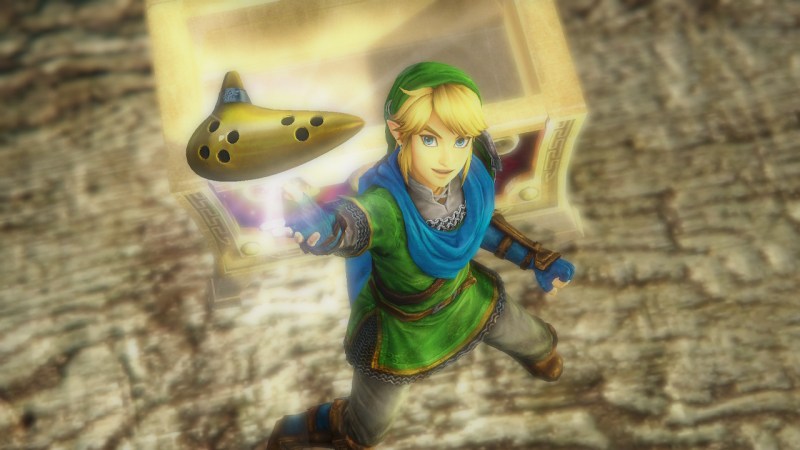
Above: If you loved it in a Zelda game, you’ll probably find it here — like Link’s ocarina, which can transport you around the battlefields.
You’ll earn weapons and crafting materials that can upgrade each character’s attacks, along with finding treasure chests filled with wall-shattering bombs, targeting arrows, Link’s classic ocarina, hook shot, and heart containers. If there wasn’t enough classic Zelda content already in the earlier versions, Nintendo added new Breath of the Wild outfits for Link and Zelda as Switch exclusives.
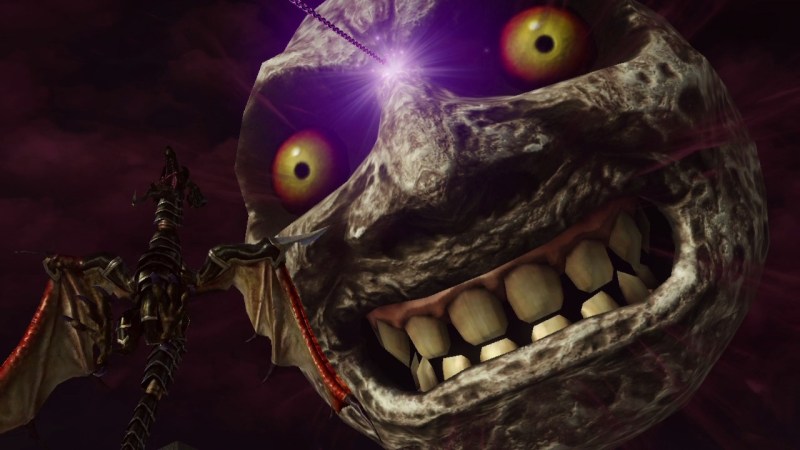
Above: Cinematics switch between CG style and Wind Waker toon art, depending on which Zelda game a level’s characters originated in.
Wonderful cinematics in multiple styles, solid audio
It’s impossible to fault Hyrule Warriors’ cinematic scenes. They vary from modern CG-quality extensions of the large-scale battles to a hand-drawn Wind Waker-style, evoking pretty much all of the varied themes employed by the last 20 years of Zelda games. Many are downright gorgeous.
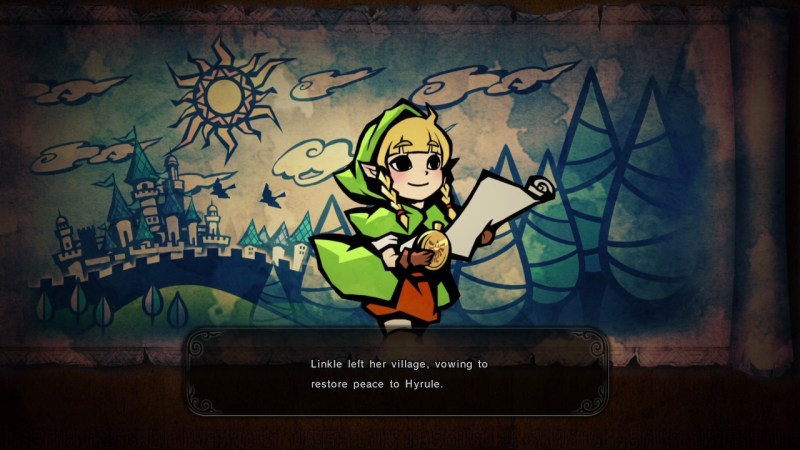
Above: A female Link? Yes, meet Linkle.
No matter which titles you liked or didn’t like, they’re lovingly represented here — from Ocarina of Time through a hint of Breath of the Wild. There’s also a reasonable quantity of familiar Zelda music, cinematic voiceovers, and fine sound effects, though the in-game voices are often puzzling.
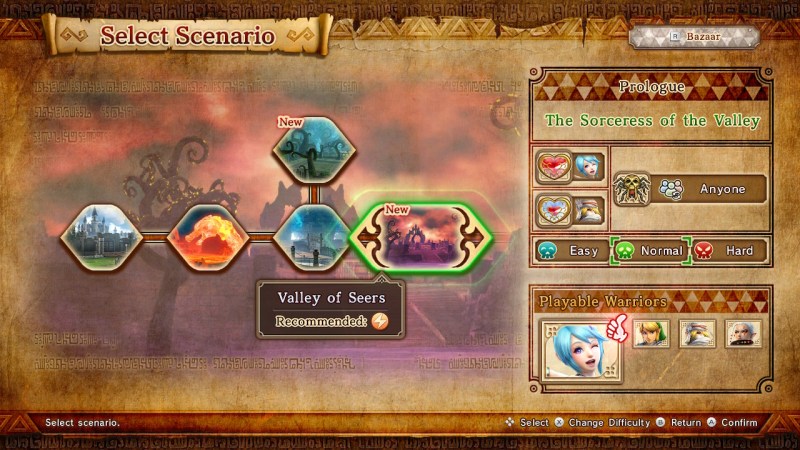
Above: Legend stages include semi-linear progression through a chapter-based adventure, and side stories.
Tons of stages without the need to buy additional DLC
Hyrule Warriors is primarily focused on a story mode called Legend, consisting of nearly 20 chapter-like stages that become challenging after level 5 — at that point, you can’t play the game as a raw brawler, even on “Easy” difficulty. But there are other modes, too. Adventure mode uses classic Zelda overworld maps to facilitate hundreds of additional battles with basic objectives (“beat 300 enemies”), but minus cinematics.
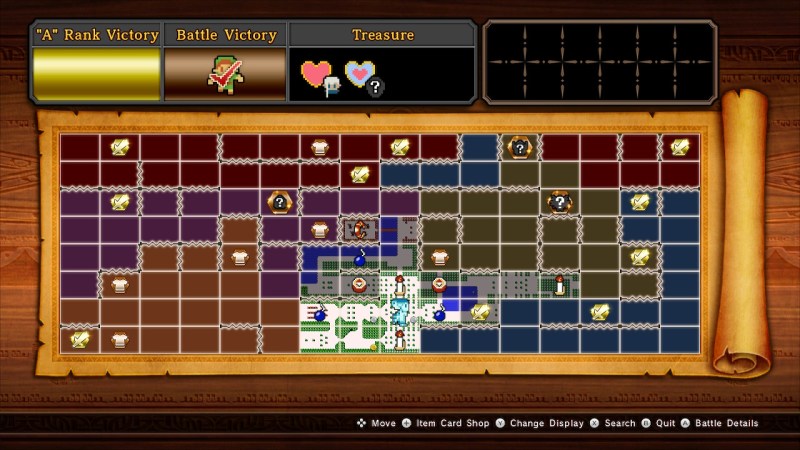
Another mode places you in control of a gigantic Ganon as he roams the game’s maps from a nearly overhead perspective, fighting grunts and multiple full bosses from the game in a King of the Monsters style experience. This mode’s amazing to look at and a ton of fun — perhaps moreso for kids than the more strategic Legend stages.

If you win every battle across the Legend and Adventure modes on the first try, you might finish the game after a week of several-hour sessions. But realistically, you won’t, and after suffering a mid-stage defeat, you’ll be given the choice to fall back to either your last save point or an automatic checkpoint. Even on easy difficulty, expect to revisit midpoints multiple times per stage, and then to move up to at least normal difficulty before completing the game.
What you won’t like
A weird difficulty curve for levels and controls
I both respect and hate what Nintendo and Koei Tecmo did with Hyrule Warriors’ difficulty curve. They recognized that first-time players won’t immediately grasp all the strategic or control nuances, so the strategy and RPG elements are background noise in the early levels. If you miss them because you’re too busy chopping up dozens of monsters, it seems like no big deal.
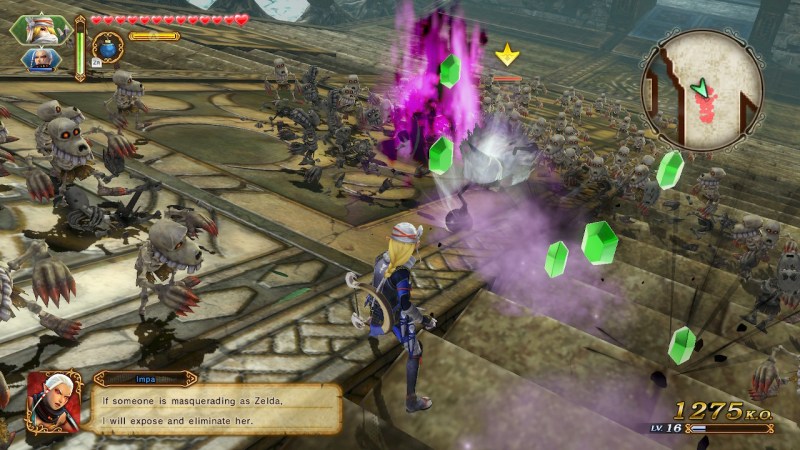
Above: Hey, did you notice the dialog box there? Can you read it?
But by the fourth or fifth level, you’ll realize that the strategic elements are a really huge deal and that you probably weren’t paying enough attention to the dialog boxes. One will tell you that a northern castle keep is under attack, or that a boss has teleported to the west. You’ll have to choose whether to run over there yourself or send an A.I.-controlled assistant to start the fight. Suddenly you’ll need to know how to toggle between the frenetic action and a game-pausing strategy screen to issue commands to multiple characters. And you’ll start suffering defeats because you didn’t respond quickly enough to pop-up events on your map, communicated by tiny on-screen dialog boxes.
I hate this because I know Nintendo could have done better. It’s the world’s best in-game teacher, organically evolving players to gradually develop important skills. But Hyrule Warriors lacks that magical Nintendo polish.

Above: Seriously, what’s going on with that navigation map?
A stupidly confusing map
Hyrule Warriors’ single worst design element is its top-right map, which is critically important yet almost impossible to use on the Switch itself or a connected TV. Your character’s current location is indicated by a tiny arrow against a background cluttered with blinking dots, spiderwebs, and icons. You might learn to hit a button for a zoomed-in view with directional guidance, but even that’s not great.
If I could only fix one thing in Hyrule Warriors, I would redesign the map and onscreen “go here next” indications for both screen sizes.
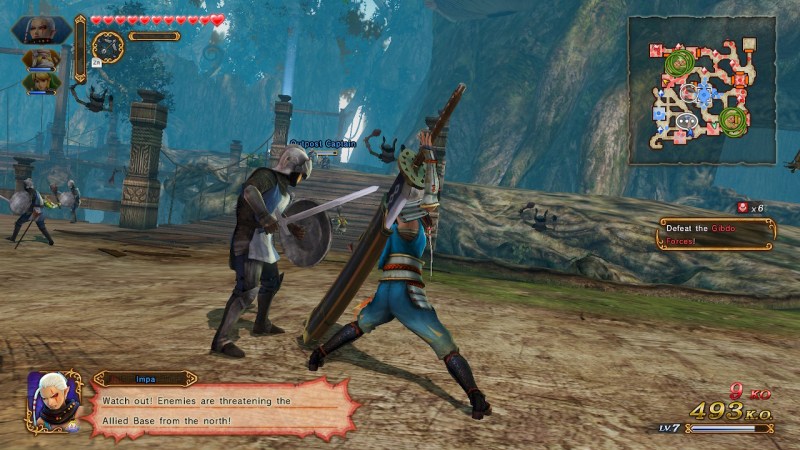
Above: Making out text in the dialog boxes can be challenging on the Switch display.
Graphics that weren’t optimized for the Switch’s screen
Hyrule Warriors suffers from an unlocked frame rate, going from split seconds of 60FPS down to stretches in the 20FPS zone, depending on the number of enemies you’re facing. That’s easy to excuse when there are tons of combatants, but the constant frame rate changes keep this from feeling like a next-level port.
Another odd thing is that Nintendo didn’t really optimize the Switch port for portable play. Beyond the map, on-screen text can be microscopic — an issue for a game where so many of your objectives are communicated through text.
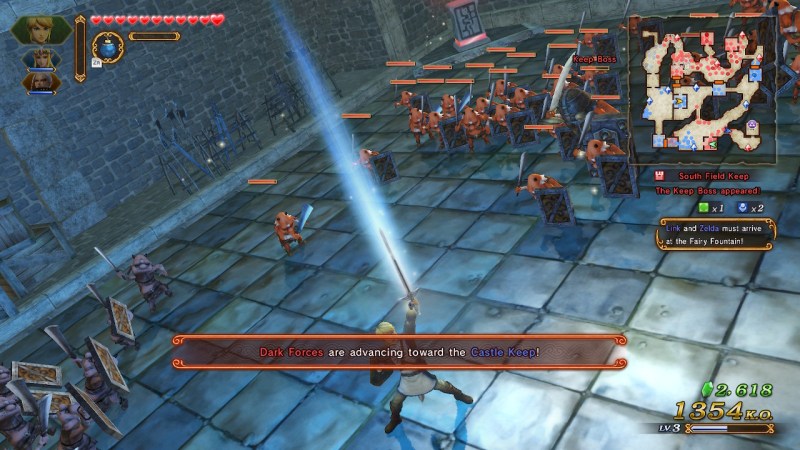
Above: Here’s just one of a level’s similar-looking castle keeps. Segments of each map can look very similar, making it hard to navigate without a directional arrow.
Repetitive gameplay
Depending on what you’re expecting, Hyrule Warriors’ samey levels might or might not bother you. I wouldn’t criticize a pure strategy game like Advance Wars for having too many similar maps, so it’s hard to criticize an action-heavy version of the same concept for having tons of repeating areas and mindless enemies to cut through.
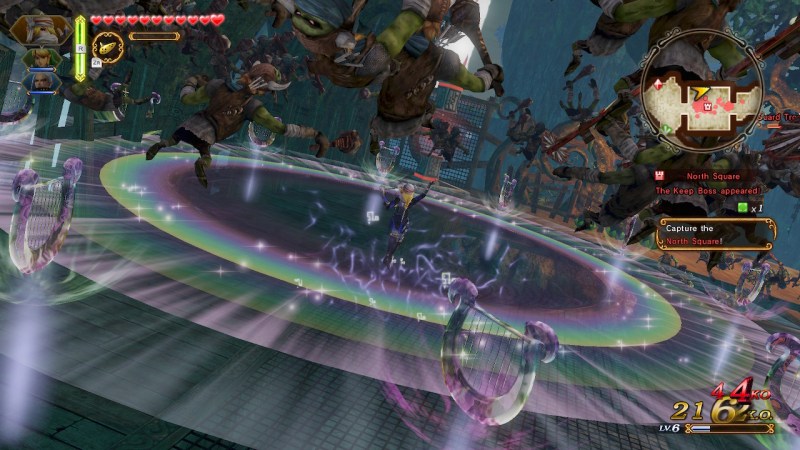
Above: At some point, mowing through dozens of enemies at once feels predictable, even though it generally looks great.
Strategy aside, the gameplay consists of a lot of button-mashing and slash-slash-slashing, interrupted by big magical blasts. From level to level, the same themes repeat and repeat, albeit with new characters and challenges. But that’s the genre’s formula, and at least the Zelda content makes the battles interesting.
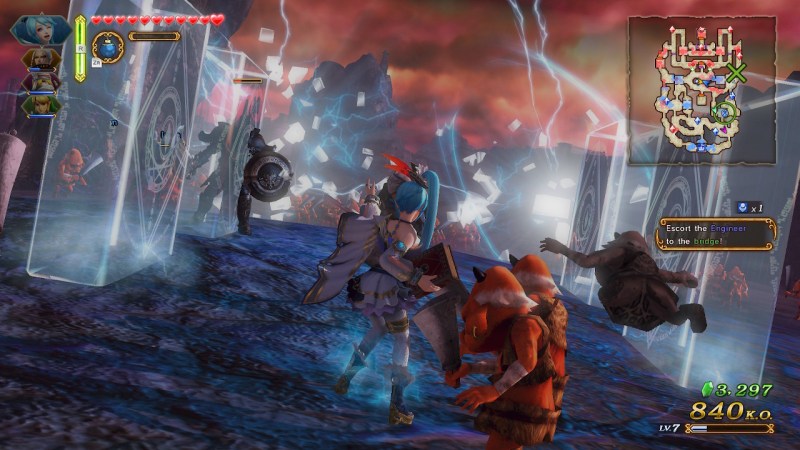
Above: Hyrule Warriors has a two-player mode, but the game is really optimized for a single-player experience.
A mostly single-player focus (but with a two-player mode)
Nintendo doesn’t go out of its way to advertise the two-player feature in Hyrule Warriors — it actually took some hunting through menus and the digital manual before I could even find the game’s split-screen mode. If a second controller is connected, you can opt to start a battle with a second person handling another character, which is actually a lot better than expecting the game’s weak A.I. to help you out.
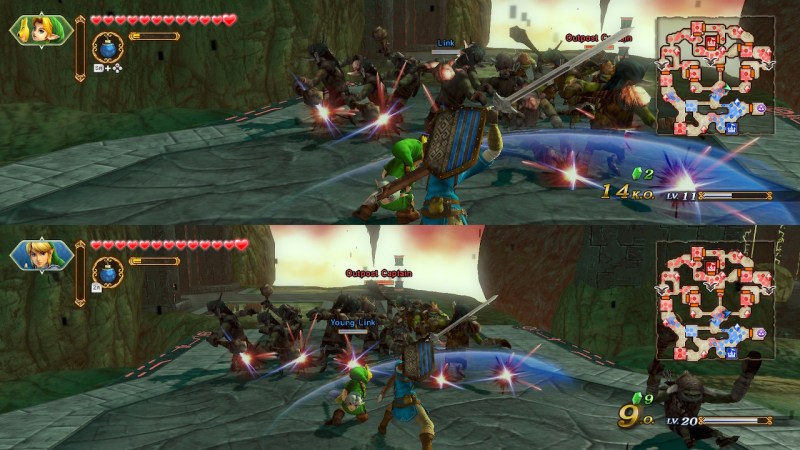
And it’s actually quite fun. The split screen cuts down the number of grunts from single-player mode, and it sometimes limits your view, impeding battles with flying dragons. But the framerate’s consistently solid. Consider this a nice bonus rather than a primary way to play the game.
Conclusion
I went into Hyrule Warriors with zero expectations and came out satisfied — this is a cool game with treats for Zelda fans, strategy fans, and hack-and-slash fans alike. It’s fun to play in two-level sessions, allocating around half an hour to an hour per level, and between the main objectives, optional missions, and side story quests, there’s an incredible amount to see and do here.
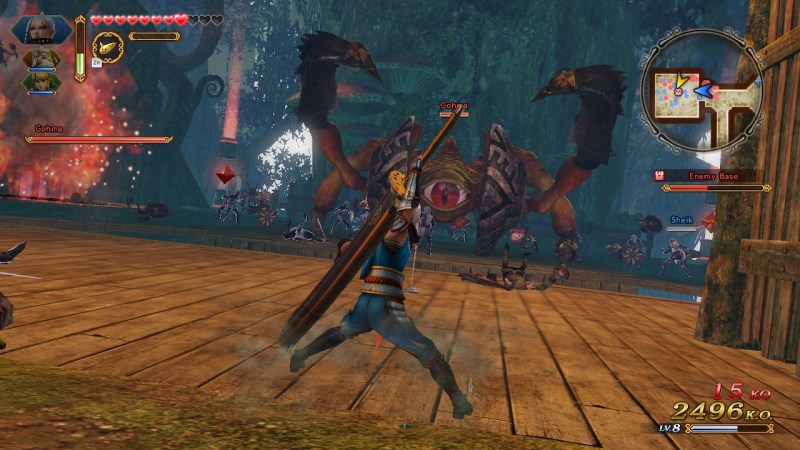
Above: Some of the Hyrule Warriors scenes, particularly during boss encounters, are just fantastic set pieces.
That said, the only reason I’d call Hyrule Warriors “good” rather than “OK” is its sheer scope. Around halfway through the Legend campaign, I got tired of mowing down crowds of soldiers, and annoyed by the game’s sub-optimal map and control UIs. But then I discovered the Adventure and Ganon modes, and felt reinvigorated by the title’s potential for variations on the lengthy Legend battles. And the more I continued to play, the more amazed I was by all of the fan service Koei Tecmo and Nintendo included.
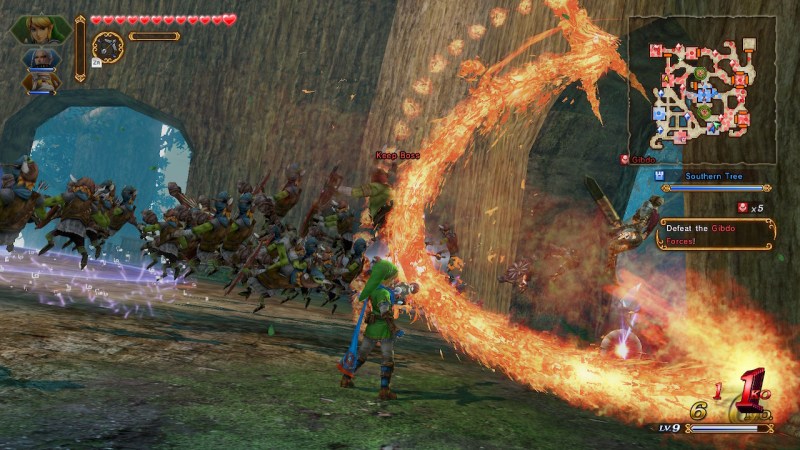
Above: Hyrule Warriors can largely be played by kids as a button masher, but strategic map management is needed on higher levels.
Overall, if you love beat-’em-ups, action-strategy games, or Zelda lore, Hyrule Warriors will be right up your alley. Given that Koei Tecmo handled most of the development, it’s surprisingly worthy of the Zelda name, but apart from its visuals and incredible breadth, you won’t confuse it with the deeper, legendary mainline series.
If Nintendo releases a patch with Switch-worthy map and text size improvements, it will merit additional consideration.
Score: 84/100
Hyrule Warriors: Definitive Edition comes out for Nintendo Switch on May 18. Nintendo sent us a code for this review.
